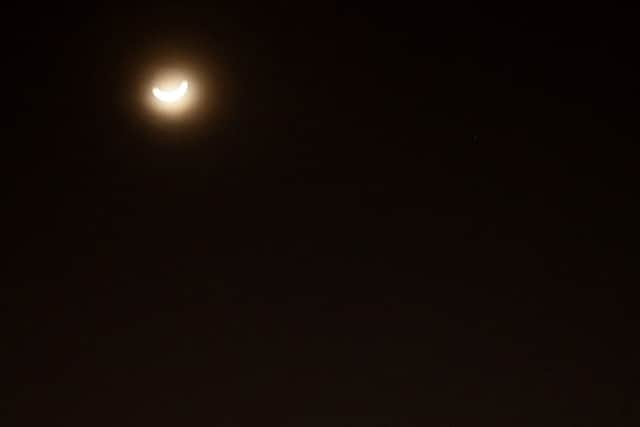Moon, Jupiter and Venus conjunction 2023: what is event, how to watch - where is alignment visible in UK
and live on Freeview channel 276
Stargazers across the UK are being treated to a spectacular view after a rare conjunction of the Moon, Jupiter and Venus was visible by the naked eye.
The Moon aligned with the two planets in the night’s sky this week, with all three visible in a line just after sunset on Wednesday (22 February). The three brightest objects in our sky, which are the largest and second largest planets in our solar system, were visible by the naked eye, with Jupiter positioned above a crescent Moon and Venus.
Advertisement
Hide AdAdvertisement
Hide AdAs the month of February comes to an end, the planets are moving closer together, with the UK Space Agency predicting they will reach their apparent closest point at the beginning of March, where they will appear to form one large bright point of light. So, how can you see the Moon, Jupiter and Venus conjunction in the UK? Here’s everything you need to know.
What is the Moon, Jupiter and Venus conjunction?
The Moon, Jupiter and Venus conjunction will see the two planets line up perfectly with the Moon in the same part of the sky. The three brightest objects in our solar system will be visible by the naked eye, the Moon will visit Venus first, which is the second planet from the sun, before moving close to the largest planet in our solar system, Jupiter.


The conjunction began on Wednesday (22 February) evening, with the UK Space Agency predicting the two planets will reach their closest point by the beginning of March, when they will appear to form one large, bright point of light visible by the naked eye.
How can I watch the Moon, Jupiter and Venus conjunction?
The conjunction has been visible across the world, including the UK since Wednesday and can be observed with the naked eye even if there is light pollution. The spectacular alignment is not over yet, further glimpses were available on Thursday (24 February) and are predicted to continue until the beginning of March.
Advertisement
Hide AdAdvertisement
Hide AdTo watch the conjunction you will need clear skies. The Met Office have predicted there will be “variable cloud” on Saturday (25 February), with showers for eastern and southern areas.
Here is the Met Office forecast up until Tuesday (28 February):
Friday 24 February: A fragmenting band of rain will push south and west across all areas, pepping up for a time for parts of England later. Clearer, colder weather follows, with some showers for northern and eastern areas. Patchy rain clears Cornwall by the early hours, leaving many areas dry overnight. Still some showers for eastern areas, wintry on hills. Widespread frost for sheltered northern and western areas.
Saturday 25 February: Often dry with variable cloud. Again, showers for some eastern, and later southern areas, locally wintry. Rather cold, or cold, with brisk winds in the south accentuating the chill.
Advertisement
Hide AdAdvertisement
Hide AdSunday 25 February - Tuesday 28 February: Often settled, if cloudy, with a few mainly light showers. Temperatures near normal away from southern areas where often rather cold. Night frosts for sheltered western and northern areas.
Where is the alignment visible in the UK?
The alignment is visible across the UK and around the world with people sharing pictures of the Moon, Venus and Jupiter conjunction from previous nights on Twitter. Whilst you can see it with the naked eye and light pollution will not affect it, clear skies are needed to catch a glimpse of the spectacle.
Comment Guidelines
National World encourages reader discussion on our stories. User feedback, insights and back-and-forth exchanges add a rich layer of context to reporting. Please review our Community Guidelines before commenting.
